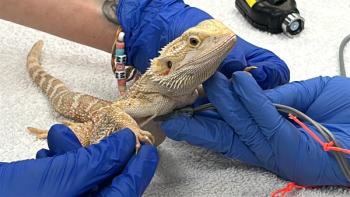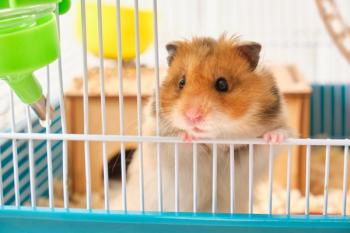
Endotracheal intubation of small exotic mammals (Proceedings)
Intubation provides better airway control than a face mask and minimizes the risk of aspiration. This is especially important for complex and prolonged procedures, when complications such as respiratory obstruction and hypoventilation are more likely to occur. Rabbits and rodents are difficult to intubate.
Intubation provides better airway control than a face mask and minimizes the risk of aspiration. This is especially important for complex and prolonged procedures, when complications such as respiratory obstruction and hypoventilation are more likely to occur. Rabbits and rodents are difficult to intubate. They have a large tongue, large molars, a small larynx, and a soft palate that easily obscures the epiglottis. While intubation of small mammals is difficult, it should be the routine standard of care all patients as long as it can be done quickly and safely.
Indications
Endotracheal intubation is the placement of a tube that extends from the oral cavity into the trachea. It is indicated for the administration of oxygen and inhalation anesthesia, to ensure a patent airway in unconscious patients, to provide ventilatory assistance, and to provide a conduit into the trachea to permit diagnostic and therapeutic measures (e.g. endoscopy, tracheal wash, direct instillation of medications).
Intubation methods
Various intubation techniques have been suggested for small mammals. Some of these require specialty equipment, and all require practice. Intubation methods can be divided into those that are performed blind or with visualization of the larynx.
Blind Intubation
By properly positioning the head and neck, the pathway from the oropharynx to the trachea is straightened so that an endotracheal tube can be placed without direct visualization of the larynx. This is possible with the aid of laryngeal palpation, patient response (i.e. coughing, gagging), and listening for patient respiration through the endotracheal tube itself. Under special circumstances, a transtracheally-placed catheter may be used as a guide.
Visual Intubation
Divided into direct visualization and indirect visualization of the glottis.
• Direct Visualization- Visualization of the larynx is aided by hyperextension of the head and neck. Usually an assistant must open the mouth with gauze placed around the upper and lower incisors, or an oral speculum is used. A small bladed laryngoscope (e.g. Miller 0 neonatal laryngoscope blade) is used to depress the tongue and elevate the soft palate. Once the vocal folds are visualized, the tube is placed. An atraumatic stylet (such as a polypropylene catheter) can be placed through the tube so its tip extends beyond the end of the endotracheal tube. Being narrower than the endotracheal tube, the stylet tip will fit easily into the trachea and help to guide the tube through the vocal folds. A canine otoscope can be used instead of a laryngoscope in smaller patients. After adequate visualization is achieved, a 5 French polypropylene urinary catheter is guided down the otoscope between the vocal folds and advanced into the trachea. At this point, the otoscope is removed and the tracheal tube is threaded over the catheter and into the larynx. The catheter guide is then removed.
• Indirect Visualization- Visualization of the trachea can also be achieved using an endoscope. The endoscope is positioned so the larynx is in view, and an endotracheal tube is passed parallel to the scope and into the trachea. Further, with some scopes it is possible to put endoscope directly inside the endotracheal tube like a stylet, and to visually guide the scope/tube assembly into the trachea.
Endotracheal tube size/style for selected species
• Ferret: 2-2.5mm ID (Cole or Murphy)
• Rabbit: 2-3.5 ID (Cole or Murphy)
• Prairie dog: 2-2.5mm ID (Cole or Murphy)
• Guinea pig: 8-fr (urinary catheter), 2-2.5mm ID (Cole or Murphy)
• Hedgehog: 1.5 mm ID (straight silicone)
• Sugar Glider: 1.5 mm ID (straight silicone)
• Chinchilla: 8-fr (urinary catheter)
• Rat: 14ga (IV catheter)
Equipment for endoscopic intubation
Currently, three types of endoscope are widely reported for endotracheal intubation in small exotic mammals: the 2.7 mm 30° Hopkins rod-lens telescope (Karl Storz Veterinary Endoscopy America, Goleta, CA), the 1.9 mm semi-rigid fiber optic endoscope (MDS Incorporated, Brandon, Fl), and 1.0 mm semi-rigid fiber optic endoscopes by Karl Storz and MDS. When used for over-the-endoscope intubation, the 2.7 mm telescope can accommodate endotracheal tubes with an internal diameter of 3.0 mm or greater. The 30° angle of the Hopkins telescope permits a clear view of the glottis over the base of the tongue, whereas the 0° angle of the semi-rigid fiber optic scope does not. However, the telescope is rigid and vulnerable to damage without its protective sheath. It should not be bent or flexed, which limits its effectiveness in patients with difficult airway or position. With a large field of view, 30° angle, and superior optics, the 2.7 mm rigid endoscope is ideal for side-by-side intubation.
The 1.0 mm and 1.9 mm semi-rigid endoscopes are fiber optic with a metal sheath. They are rigid enough to push the soft palate and to direct the endotracheal tube, yet able to flex without being damaged. Because they are semi-rigid, the fiber optic endoscopes are less dependent on patient positioning and ideal for over-the-endoscope intubation, which can typically be performed by one person. The 1.9 mm semi-rigid scope can accommodate endotracheal tubes down to 2.0 mm for over-the-endoscope intubation, and the 1.0 mm semi-rigid scope accommodate a 1.5 mm endotracheal tube. Both are also suitable for side-by-side intubation; however, the smaller size and fiber optics give the semi-rigid endoscopes a lower quality image than the Hopkins rod-lens telescope.
Light for endoscopic intubation is usually provided by a tabletop light source and conveyed to the endoscope by a fiber optic light guide cable. Endoscopic intubation may also be performed with the aid of a camera and video monitor. A variety of interchangeable light source, video camera, video display options are available for all of these endoscopes. For portability and simplicity, the author prefers to intubate by looking directly through the scope and using a handheld light source.
Comments on individual species
Ferrets
While direct placement of an endotracheal tube in ferrets is relatively simple, it usually requires two people. The jaw tone of ferrets often remains high even at moderate levels of anesthesia, therefore one person must hold the jaws apart while the other pulls the tongue forward and places the tube. Over-the-endoscope intubation of ferrets simplifies intubation because it does not require the jaws to be opened wide or the tongue to be pulled forward. The endoscope/tube combination is rigid enough force the tongue forward at its base, exposing the glottis. The tube and scope are advanced over the epiglottis and into the trachea. Either a 2mm Cole or 2.5mm Murphy ET tube is recommended for intubating ferrets with this technique
Rabbits
Rabbits are notoriously prone to laryngospasm and intubating them can be a challenge. The rabbit's glottis is small, its tongue is so shaped that it hides the larynx, and its larynx is smaller than its trachea. Endotracheal intubation is easiest in large breeds. The rabbit's trachea is long and bifurcates into main stem bronchi at an angle such that accidental intubation of one bronchus is unlikely. Rupture of the trachea at the bifurcation, however, can easily occur; pre-measuring the ET tube is essential. Cole endotracheal tubes, with their short beveled tips, have a tendency to become extubated with head motion because of the rabbit's long, mobile trachea. The vocal cords of the rabbit are very strong and can easily deflect the tip of the endotracheal tube into the esophagus. Insertion of the tracheal tube therefore has to occur during inspiration, when the vocal cords are open.
Blind placement of an endotracheal tube in the rabbit is usually described with the rabbit in sternal position. The operator uses one hand to elevate the head, hyperextending the neck, while the other hand directs the tube. Then the operator puts his ear to the end of the tube, and listens to the respiratory sounds in order to place the tube. A modification of this blind technique involves attaching the endotracheal tube to a standard clinical stethoscope. The endotracheal tube is advanced into the trachea during early inspiration. Proper placement results in a cough.
A blind method of endotracheal intubation that involves percutaneous preplacement of a polyethylene urinary catheter retrograde via a transtracheal guide needle has also been described.
Over-the-endoscope intubation provides indirect visualization of the glottis during intubation, and can be accomplished by a solo operator. The author uses a 1.9mm x 6" semi-rigid fiber optic endoscope (Focuscope, MDS Inc.), which is compatible with endotracheal tubes having an internal diameter (ID) of 2.0mm and greater. The endoscope acts as a stylet for the ET tube.
Prairie dogs
Prairie dogs can be intubated in a manner similar to that described for rabbits. They are generally more difficult to intubate as the glottal opening is slightly smaller than in rabbits. The soft palate of the prairie dog appears to be longer and under less tension than in the rabbit and it is more difficult to keep soft palate from obscuring the glottis. The author prefers to place prairie dogs in sternal recumbency for intubation, and uses either of the endoscopic methods described above to visualize the laryngeal opening. A 2.5mm uncuffed Murphy oral-nasal or a 2mm Cole endotracheal tubes are recommended.
Guinea pigs/chinchillas
Cavies and chinchillas are generally harder to intubate than the species discussed above. This is due in part to the small size of their laryngeal openings. Guinea pigs and, to a lesser extent, chinchillas have a narrow palatial ostium formed by the soft palate, palatoglossal arches, and tongue. Atropine or glycopyrrolate may be indicated to decrease salivary secretions, especially in guinea pigs, which tend to exhibit profuse hypersalivation under anesthesia. Guinea pigs (and smaller rabbits) can be successfully intubated using a canine otoscope for visualization of the larynx, and a 5-fr urinary catheter as a guide for the endotracheal tube. Over-the-endoscope intubation of cavies and chinchillas is possible with a 2mm Cole or Murphy endotracheal tube.
Hedgehog/sugar glider
The hedgehog and sugar glider can be intubated with a 1.5 mm small exotic straight silicone endotracheal tube or one constructed from other materials. Using the 2.7 mm 30° rigid or the 1.9 mm semi-rigid scope requires side-by-side intubation. However, with a 1.0 mm semi-rigid fiber optic endoscope, these species can be successfully intubated using the over-the-endoscope method.
Rats, other small mammals
The author has had repeated success intubating a grey squirrel using a 1.0 mm semi-rigid fiberscope and a 1.5 mm straight endotracheal tube using the over-the-endoscope technique. This method can be applied to rats and other mammals of similar size. Intubation of mammals smaller than the rat may require the side-by-side technique using either the 1.0 mm small exotic straight silicone endotracheal tube or tubes constructed from intravenous or urinary catheters.
Confirming proper position
With blind intubation, proper positioning is assessed indirectly: the corrugations of the trachea may be felt as the tube is passed; the patient may cough; condensation can be seen inside the endotracheal tube or on glass or metal placed at the end of the tube; air movement can be detected by listening for breath sounds and watching for movement of the non-rebreathing bag or a hair placed at the end of the tube. With visual methods of intubation, proper positioning is determined using all of the methods discussed above. With direct visualization, however, the operator also has direct visual evidence that the tube has been properly placed. He sees the tube as it passes through the vocal folds and, with the over-the-endoscope method, actually sees the inside of the trachea. This is considered the "gold-standard" for confirming ET tube position.
References
Johnson DH. Endoscopic intubation of exotic companion mammals. Veterinary Clinics of North America: Exotic Animal Practice, 13(2) 2010:273-289.
Johnson DH. Over-the-endoscope endotracheal intubation of small exotic mammals. Exotic DVM 2005;7(2):18-23.
Mason DE. Anesthesia, analgesia, and sedation for small mammals. In: Hillyer EV, Quesenberry KE, eds. Ferrets, Rabbits, and Rodents: Clinical Medicine and Surgery. Philadelphia: WB Saunders, 1997; 382-387.
Heard DJ. Anesthesia, analgesia, and sedation of small mammals. In: Quesenberry K, Carpenter J. Ferrets, Rabbits, and Rodents: Clinical Medicine and Surgery, 2nd Ed. St. Louis: Saunders, 2004;362-365.
Cantwell SL. Ferret, rabbit, and rodent anesthesia. Vet Clin N AmerExotic Animal 4:1. Philadelphia: WB Saunders, 2001;169-191.
Briscoe JA, Syring R. Techniques for emergency airway and vascular access in special species. Semin Avian Exotic Pet Med 13:3. Philadelphia: WB Saunders, 2004;119-125.
Newsletter
From exam room tips to practice management insights, get trusted veterinary news delivered straight to your inbox—subscribe to dvm360.






